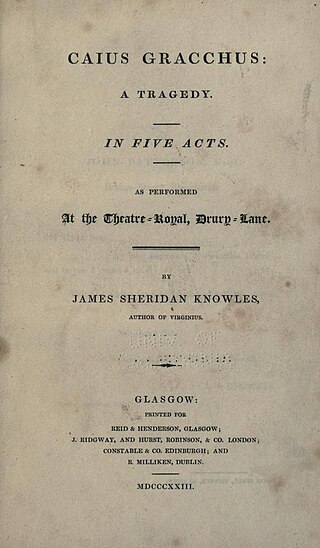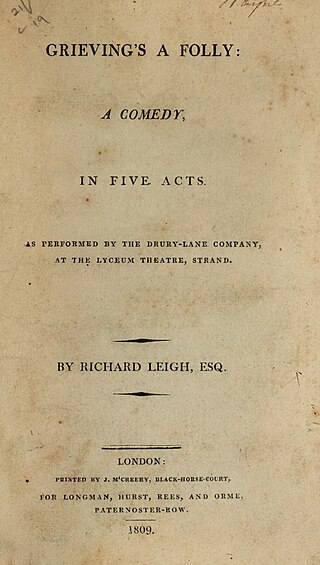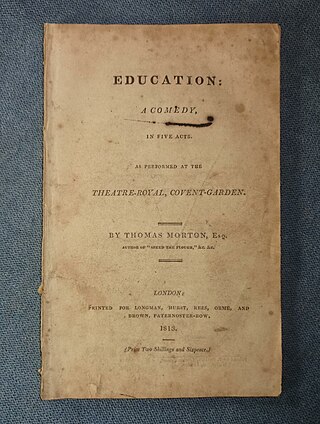Related Research Articles

William Charles Macready was an English stage actor.

Robert William Elliston was an English actor and theatre manager.
John Tobin was a British playwright, who was for most of his life unsuccessful, but in the year of his death made a hit with The Honey Moon. Other plays were The Curfew and The School for Authors.

The Theatre Royal, Drury Lane, commonly known as Drury Lane, is a West End theatre and Grade I listed building in Covent Garden, London, England. The building faces Catherine Street and backs onto Drury Lane. The building is the most recent in a line of four theatres which were built at the same location, the earliest of which dated back to 1663, making it the oldest theatre site in London still in use. According to the author Peter Thomson, for its first two centuries, Drury Lane could "reasonably have claimed to be London's leading theatre". For most of that time, it was one of a handful of patent theatres, granted monopoly rights to the production of "legitimate" drama in London.
Events from the year 1809 in the United Kingdom.
Events from the year 1814 in the United Kingdom.
Events from the year 1808 in the United Kingdom.
Thomas Shaw was an English violinist, violist, clarinettist and composer who was born c.1752, probably in Bath, and who probably died in Paris on 28 June 1827 or c.1830. Thomas Shaw was the son of Bathonian musician Thomas Shaw and the younger brother of violinist Anthony Shaw. The majority of his career was spent at the Drury Lane theatre in London as an instrumentalist, violin soloist, band leader, musical director and in-house composer.

John Bannister, , English actor and theatre manager. The principal source for his life are his own Memoirs, and as a leading performer his career is well documented.
The Battle of Hastings is a 1778 play by the English writer Richard Cumberland. It is a tragedy set around the Battle of Hastings in 1066. It was staged at the Drury Lane Theatre in October 1778 by Richard Brinsley Sheridan. Sheridan later mocked Cumberland's sensitivity to criticism by modelling the character Sir Fretful Plagiary, in his 1779 play The Critic, after him.

Thomas Sheridan, known as Tom Sheridan, was the only son of the Irish playwright and poet Richard Brinsley Sheridan and the soprano Elizabeth Ann Linley, although his father had at least one other son from a second marriage. Born in mid-November 1775, Thomas initially tried for a career in politics but was unsuccessful.

The Fair Circassian is a 1781 tragedy by the British writer Samuel Jackson Pratt. It is an adaptation of the novel Almoran and Hamet by John Hawkesworth. He wrote the lead role for his friend Sarah Siddons, but due to other commitments it ended up being played by Elizabeth Farren.

Arabella Menage, also known as Mrs. Sharp, was a British actress and ballet dancer. She was the wife of the artist Michael William Sharp.
The Massacre of Paris is a 1689 tragedy by the English writer Nathaniel Lee. It was first staged by the United Company at the Theatre Royal, Drury Lane. It is based around the 1572 St. Bartholomew's Day massacre which led the killing of many Huguenots during the French Wars of Religion. The events had previously been portrayed in Christopher Marlowe's Elizabethan play The Massacre at Paris.

The Beggar's Daughter of Bethnal Green is a five-act comedy play by the Irish writer James Sheridan Knowles. It was first staged at the Theatre Royal, Drury Lane in 1828 in London. It takes its name from a traditional popular song of the same name. On its opening night the audience began heckling in the second act, and by the third act, their dissatisfaction had become so tumultuous that the stage manager "implored a patient hearing, pledging himself that if the opinion of the audience was so decidedly against the piece at its conclusion, it should be withdrawn". The play was harshly criticised by the press for its weakness, lack of action, thinly sketched characters and lack of originality. In 1834 a revised version entitled The Beggar of Bethnal Green was staged at the Victoria Theatre. The action takes place in London and Romford, then in Essex.

The Curfew is a historical tragedy by the British writer John Tobin which was first published in 1807, three years after the author's death. It was staged by Richard Brinsley Sheridan at the Theatre Royal, Drury Lane in London premiering on 19 February 1807. The cast included William Barrymore as Hugh de Tracy, John Bannister as Robert, Henry Siddons as Bertrand, William Penley as Walter, Robert William Elliston as Fitzharding, Edmund John Eyre as Philip, Jane Powell as Matilda and Maria Duncan as Florence. It appeared at the Crow Street Theatre in Dublin on 1 April the same year. It is set during the Norman era.

Caius Gracchus is a tragedy by the Irish playwright James Sheridan Knowles. It is based on the life of Gaius Gracchus, a politician in Ancient Rome. The play premiered at the Belfast Theatre in 1815 and enjoyed a good reception. It debuted in London's West End at the Theatre Royal, Drury Lane on 18 November 1823, following the success of the author's Virginius. The London cast included William Macready as Caius Gracchus, William Penley as Licinius, Alexander Pope as Drusus, Daniel Terry as Titus, Charles Mayne Young as Vettius, George Yarnold as Fulvius Flaccus, Thomas Archer as Opimius, Mrs. West as Licinia and Margaret Bunn as Cornelia.

Grieving's a Folly is an 1809 comedy play by the British writer Richard Leigh. It premiered on 21 April 1809 at the Lyceum Theatre in London, which was being used the Drury Lane company while their own theatre was being rebuilt after a fire. The cast included Henry Siddons as Mr Herbert, Harriet Siddons as Ellen, William Dowton as Sir Oliver Cypress, William Powell as Belford, John Bannister as Crape, John Henry Johnstone as O'Harrolan, Charles Mathews as Joe Thresher, Walter Maddocks as Jonathon, Jane Powell as Mrs Mordaunt and Frances Maria Kelly as Susan Woodburn. The prologue was written and spoken by Edmund John Eyre. It enjoyed a successful run and was published by Longmans the same year. A second play by Leigh Where to Find a Friend was performed by the company in 1811.

Education is an 1813 comedy play by the British writer Thomas Morton. It premiered at the Theatre Royal, Covent Garden in London on 27 April 1813. The original cast included Charles Mayne Young as Count Villars, Charles Mathews as Sir Guy Stanch, John Fawcett as Mr. Templeton, Charles Kemble as Vincent Templeton, John Liston as Suckling, William Barrymore as Damper, John Emery as Broadcast, Mary Catherine Bolton as Rosine, Maria Theresa Kemble as Mrs Templeton, Sarah Booth as Ellen and Mary Ann Davenport as Dame Broadcast.
John Duruset (1793–1843) was a British stage actor and singer. He is also known as Jack Duruset and John Durousset. Born in London and showing a gift, he was apprenticed to the Italian composer and music teacher Domenico Corri. An early role came in Theodore Hook's The Siege of St Quintin (1808) at Drury Lane. Following the Drury Lane Fire of 1809 he moved with the company to the Lyceum Theatre. From 1810 was a regular for many years at the Theatre Royal, Covent Garden. He acted in many comic operas and musicals, as well as straight tragedies and non-musical comedies. He featured in the theatrical reviews of William Hazlitt.